Investigating Biomedical Aspects of Acupuncture: An Essay
VerifiedAdded on 2022/09/11
|16
|2181
|16
Essay
AI Summary
This essay delves into the biomedical aspects of acupuncture, investigating its therapeutic effects within the contexts of both Traditional Chinese Medicine (TCM) and biomedicine. The paper begins with an introduction to acupuncture and its origins in TCM, outlining the core principles of this ancient practice, including the concept of Qi flow through meridians. The essay then transitions to the biomedical perspective, discussing the proposed physiological mechanisms of acupuncture. These mechanisms include the anti-inflammatory effects, focusing on how acupuncture reduces swelling and local inflammation, potentially through the regulation of specific genes and cytokine levels. The essay also explores the role of increased local blood flow, explaining how acupuncture might elevate nitric oxide levels, thereby improving circulation. Furthermore, it examines the involvement of neurotransmitters, such as endogenous opioids and substance P, in the analgesic effects of acupuncture. The conclusion emphasizes the need for a holistic understanding of acupuncture's mechanisms, combining insights from both TCM and biomedical research to fully appreciate its therapeutic potential.
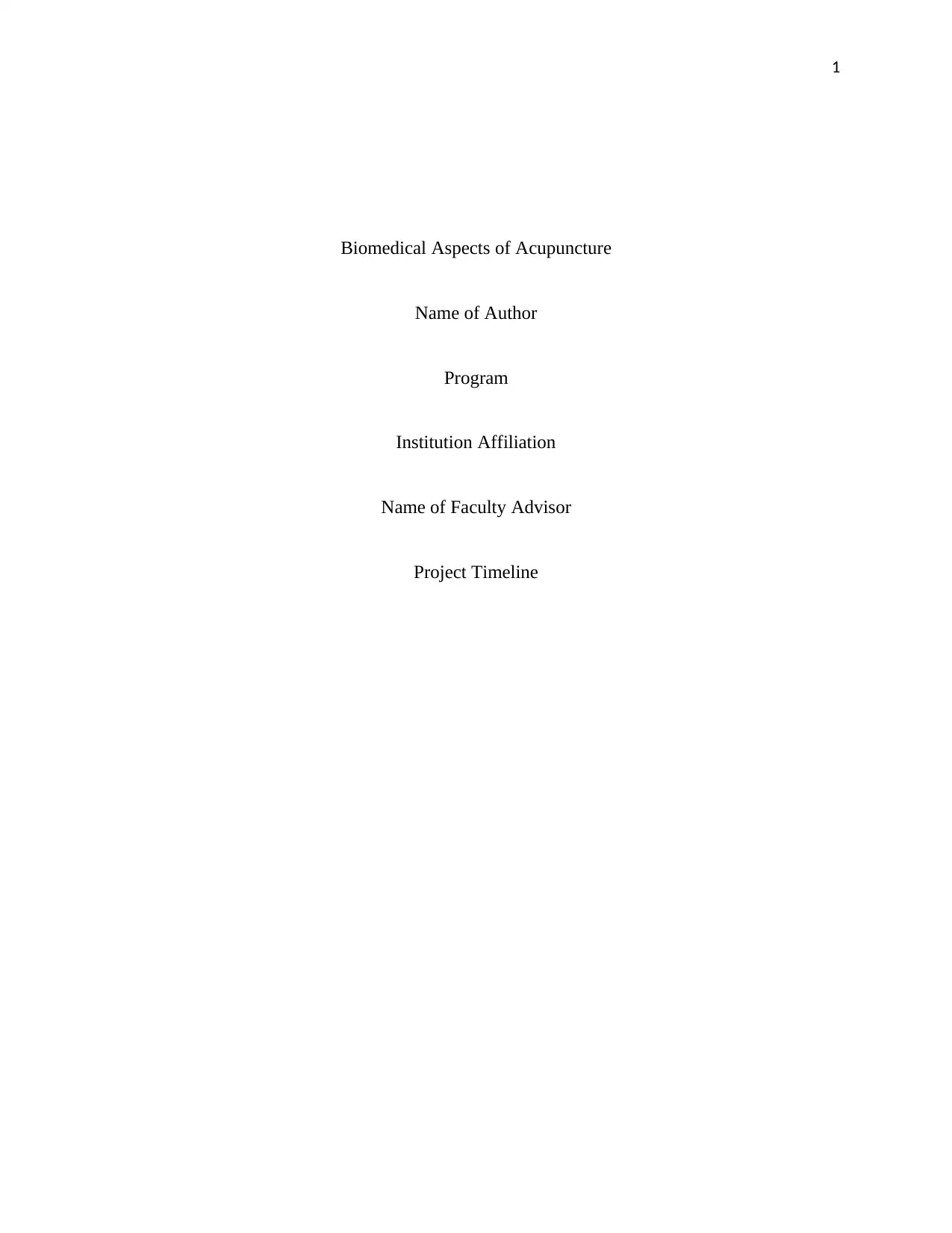
1
Biomedical Aspects of Acupuncture
Name of Author
Program
Institution Affiliation
Name of Faculty Advisor
Project Timeline
Biomedical Aspects of Acupuncture
Name of Author
Program
Institution Affiliation
Name of Faculty Advisor
Project Timeline
Paraphrase This Document
Need a fresh take? Get an instant paraphrase of this document with our AI Paraphraser
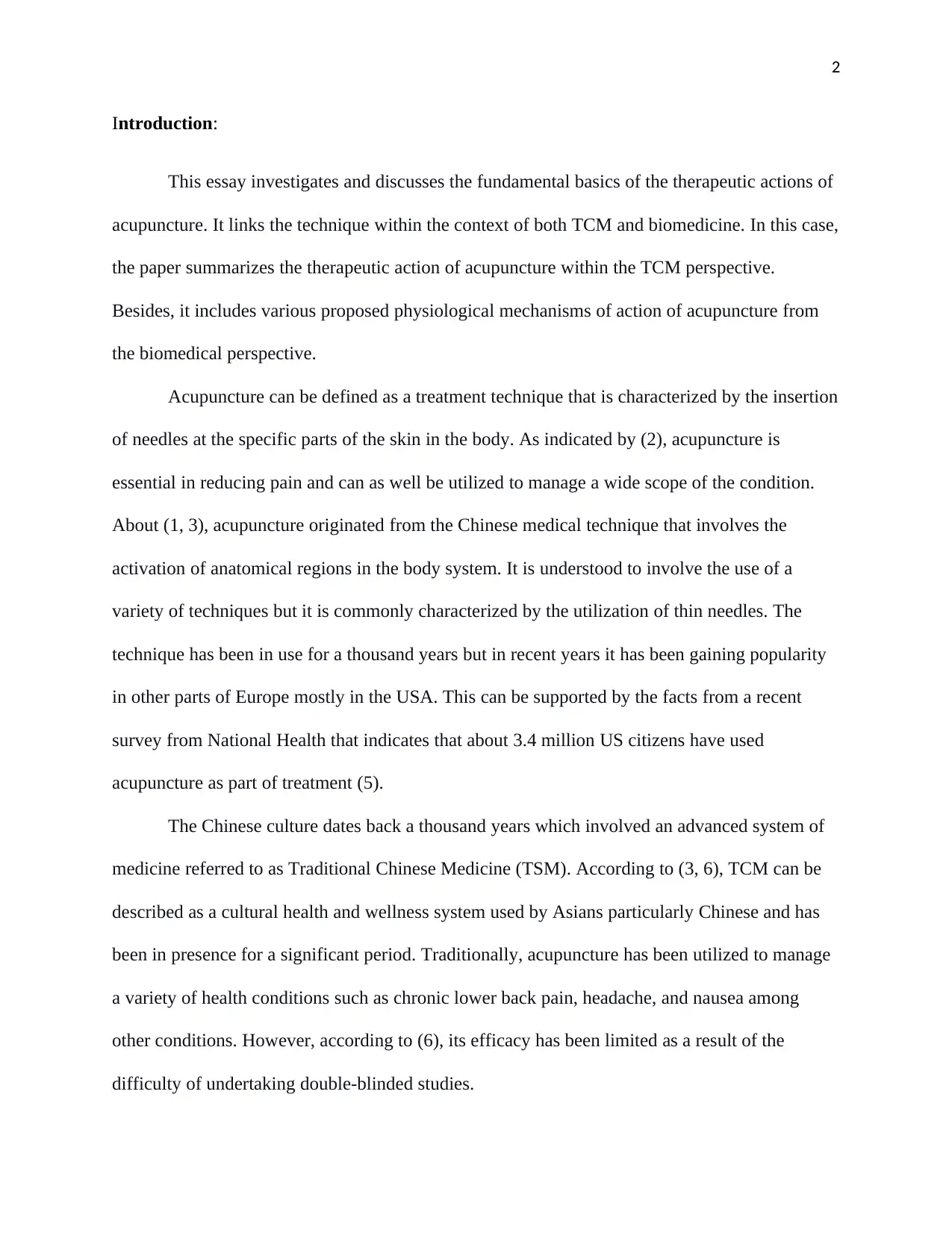
2
Introduction:
This essay investigates and discusses the fundamental basics of the therapeutic actions of
acupuncture. It links the technique within the context of both TCM and biomedicine. In this case,
the paper summarizes the therapeutic action of acupuncture within the TCM perspective.
Besides, it includes various proposed physiological mechanisms of action of acupuncture from
the biomedical perspective.
Acupuncture can be defined as a treatment technique that is characterized by the insertion
of needles at the specific parts of the skin in the body. As indicated by (2), acupuncture is
essential in reducing pain and can as well be utilized to manage a wide scope of the condition.
About (1, 3), acupuncture originated from the Chinese medical technique that involves the
activation of anatomical regions in the body system. It is understood to involve the use of a
variety of techniques but it is commonly characterized by the utilization of thin needles. The
technique has been in use for a thousand years but in recent years it has been gaining popularity
in other parts of Europe mostly in the USA. This can be supported by the facts from a recent
survey from National Health that indicates that about 3.4 million US citizens have used
acupuncture as part of treatment (5).
The Chinese culture dates back a thousand years which involved an advanced system of
medicine referred to as Traditional Chinese Medicine (TSM). According to (3, 6), TCM can be
described as a cultural health and wellness system used by Asians particularly Chinese and has
been in presence for a significant period. Traditionally, acupuncture has been utilized to manage
a variety of health conditions such as chronic lower back pain, headache, and nausea among
other conditions. However, according to (6), its efficacy has been limited as a result of the
difficulty of undertaking double-blinded studies.
Introduction:
This essay investigates and discusses the fundamental basics of the therapeutic actions of
acupuncture. It links the technique within the context of both TCM and biomedicine. In this case,
the paper summarizes the therapeutic action of acupuncture within the TCM perspective.
Besides, it includes various proposed physiological mechanisms of action of acupuncture from
the biomedical perspective.
Acupuncture can be defined as a treatment technique that is characterized by the insertion
of needles at the specific parts of the skin in the body. As indicated by (2), acupuncture is
essential in reducing pain and can as well be utilized to manage a wide scope of the condition.
About (1, 3), acupuncture originated from the Chinese medical technique that involves the
activation of anatomical regions in the body system. It is understood to involve the use of a
variety of techniques but it is commonly characterized by the utilization of thin needles. The
technique has been in use for a thousand years but in recent years it has been gaining popularity
in other parts of Europe mostly in the USA. This can be supported by the facts from a recent
survey from National Health that indicates that about 3.4 million US citizens have used
acupuncture as part of treatment (5).
The Chinese culture dates back a thousand years which involved an advanced system of
medicine referred to as Traditional Chinese Medicine (TSM). According to (3, 6), TCM can be
described as a cultural health and wellness system used by Asians particularly Chinese and has
been in presence for a significant period. Traditionally, acupuncture has been utilized to manage
a variety of health conditions such as chronic lower back pain, headache, and nausea among
other conditions. However, according to (6), its efficacy has been limited as a result of the
difficulty of undertaking double-blinded studies.
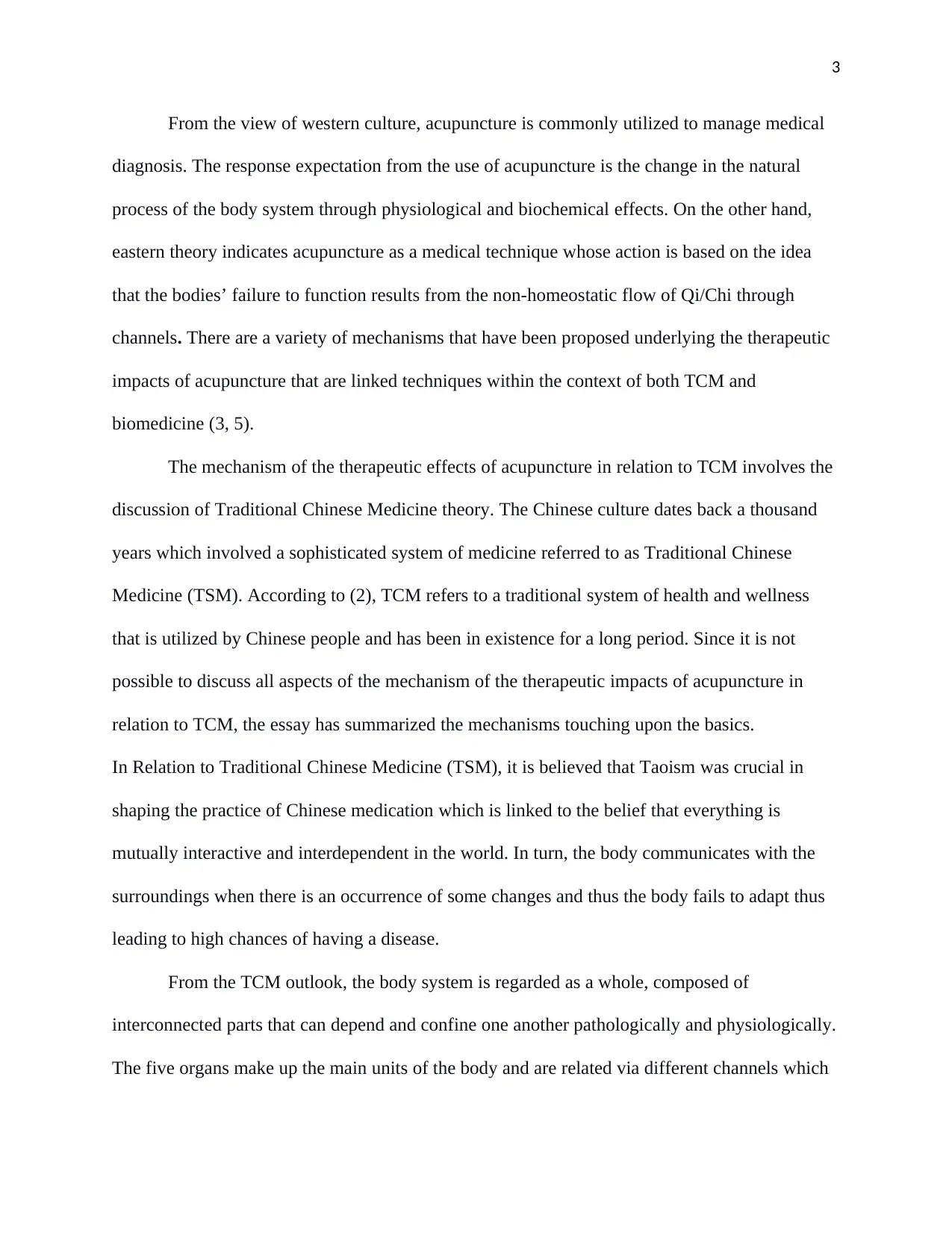
3
From the view of western culture, acupuncture is commonly utilized to manage medical
diagnosis. The response expectation from the use of acupuncture is the change in the natural
process of the body system through physiological and biochemical effects. On the other hand,
eastern theory indicates acupuncture as a medical technique whose action is based on the idea
that the bodies’ failure to function results from the non-homeostatic flow of Qi/Chi through
channels. There are a variety of mechanisms that have been proposed underlying the therapeutic
impacts of acupuncture that are linked techniques within the context of both TCM and
biomedicine (3, 5).
The mechanism of the therapeutic effects of acupuncture in relation to TCM involves the
discussion of Traditional Chinese Medicine theory. The Chinese culture dates back a thousand
years which involved a sophisticated system of medicine referred to as Traditional Chinese
Medicine (TSM). According to (2), TCM refers to a traditional system of health and wellness
that is utilized by Chinese people and has been in existence for a long period. Since it is not
possible to discuss all aspects of the mechanism of the therapeutic impacts of acupuncture in
relation to TCM, the essay has summarized the mechanisms touching upon the basics.
In Relation to Traditional Chinese Medicine (TSM), it is believed that Taoism was crucial in
shaping the practice of Chinese medication which is linked to the belief that everything is
mutually interactive and interdependent in the world. In turn, the body communicates with the
surroundings when there is an occurrence of some changes and thus the body fails to adapt thus
leading to high chances of having a disease.
From the TCM outlook, the body system is regarded as a whole, composed of
interconnected parts that can depend and confine one another pathologically and physiologically.
The five organs make up the main units of the body and are related via different channels which
From the view of western culture, acupuncture is commonly utilized to manage medical
diagnosis. The response expectation from the use of acupuncture is the change in the natural
process of the body system through physiological and biochemical effects. On the other hand,
eastern theory indicates acupuncture as a medical technique whose action is based on the idea
that the bodies’ failure to function results from the non-homeostatic flow of Qi/Chi through
channels. There are a variety of mechanisms that have been proposed underlying the therapeutic
impacts of acupuncture that are linked techniques within the context of both TCM and
biomedicine (3, 5).
The mechanism of the therapeutic effects of acupuncture in relation to TCM involves the
discussion of Traditional Chinese Medicine theory. The Chinese culture dates back a thousand
years which involved a sophisticated system of medicine referred to as Traditional Chinese
Medicine (TSM). According to (2), TCM refers to a traditional system of health and wellness
that is utilized by Chinese people and has been in existence for a long period. Since it is not
possible to discuss all aspects of the mechanism of the therapeutic impacts of acupuncture in
relation to TCM, the essay has summarized the mechanisms touching upon the basics.
In Relation to Traditional Chinese Medicine (TSM), it is believed that Taoism was crucial in
shaping the practice of Chinese medication which is linked to the belief that everything is
mutually interactive and interdependent in the world. In turn, the body communicates with the
surroundings when there is an occurrence of some changes and thus the body fails to adapt thus
leading to high chances of having a disease.
From the TCM outlook, the body system is regarded as a whole, composed of
interconnected parts that can depend and confine one another pathologically and physiologically.
The five organs make up the main units of the body and are related via different channels which
⊘ This is a preview!⊘
Do you want full access?
Subscribe today to unlock all pages.

Trusted by 1+ million students worldwide
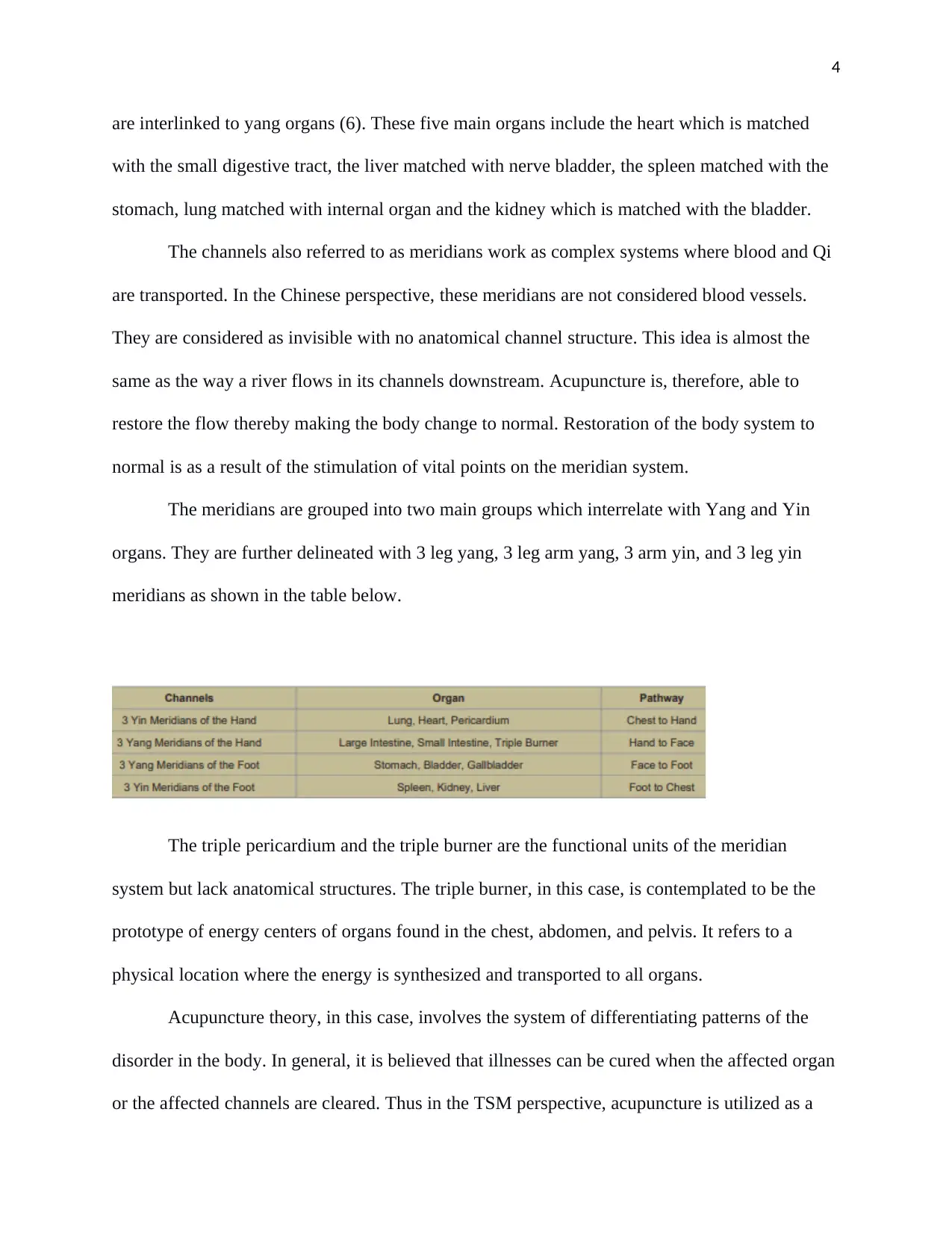
4
are interlinked to yang organs (6). These five main organs include the heart which is matched
with the small digestive tract, the liver matched with nerve bladder, the spleen matched with the
stomach, lung matched with internal organ and the kidney which is matched with the bladder.
The channels also referred to as meridians work as complex systems where blood and Qi
are transported. In the Chinese perspective, these meridians are not considered blood vessels.
They are considered as invisible with no anatomical channel structure. This idea is almost the
same as the way a river flows in its channels downstream. Acupuncture is, therefore, able to
restore the flow thereby making the body change to normal. Restoration of the body system to
normal is as a result of the stimulation of vital points on the meridian system.
The meridians are grouped into two main groups which interrelate with Yang and Yin
organs. They are further delineated with 3 leg yang, 3 leg arm yang, 3 arm yin, and 3 leg yin
meridians as shown in the table below.
The triple pericardium and the triple burner are the functional units of the meridian
system but lack anatomical structures. The triple burner, in this case, is contemplated to be the
prototype of energy centers of organs found in the chest, abdomen, and pelvis. It refers to a
physical location where the energy is synthesized and transported to all organs.
Acupuncture theory, in this case, involves the system of differentiating patterns of the
disorder in the body. In general, it is believed that illnesses can be cured when the affected organ
or the affected channels are cleared. Thus in the TSM perspective, acupuncture is utilized as a
are interlinked to yang organs (6). These five main organs include the heart which is matched
with the small digestive tract, the liver matched with nerve bladder, the spleen matched with the
stomach, lung matched with internal organ and the kidney which is matched with the bladder.
The channels also referred to as meridians work as complex systems where blood and Qi
are transported. In the Chinese perspective, these meridians are not considered blood vessels.
They are considered as invisible with no anatomical channel structure. This idea is almost the
same as the way a river flows in its channels downstream. Acupuncture is, therefore, able to
restore the flow thereby making the body change to normal. Restoration of the body system to
normal is as a result of the stimulation of vital points on the meridian system.
The meridians are grouped into two main groups which interrelate with Yang and Yin
organs. They are further delineated with 3 leg yang, 3 leg arm yang, 3 arm yin, and 3 leg yin
meridians as shown in the table below.
The triple pericardium and the triple burner are the functional units of the meridian
system but lack anatomical structures. The triple burner, in this case, is contemplated to be the
prototype of energy centers of organs found in the chest, abdomen, and pelvis. It refers to a
physical location where the energy is synthesized and transported to all organs.
Acupuncture theory, in this case, involves the system of differentiating patterns of the
disorder in the body. In general, it is believed that illnesses can be cured when the affected organ
or the affected channels are cleared. Thus in the TSM perspective, acupuncture is utilized as a
Paraphrase This Document
Need a fresh take? Get an instant paraphrase of this document with our AI Paraphraser
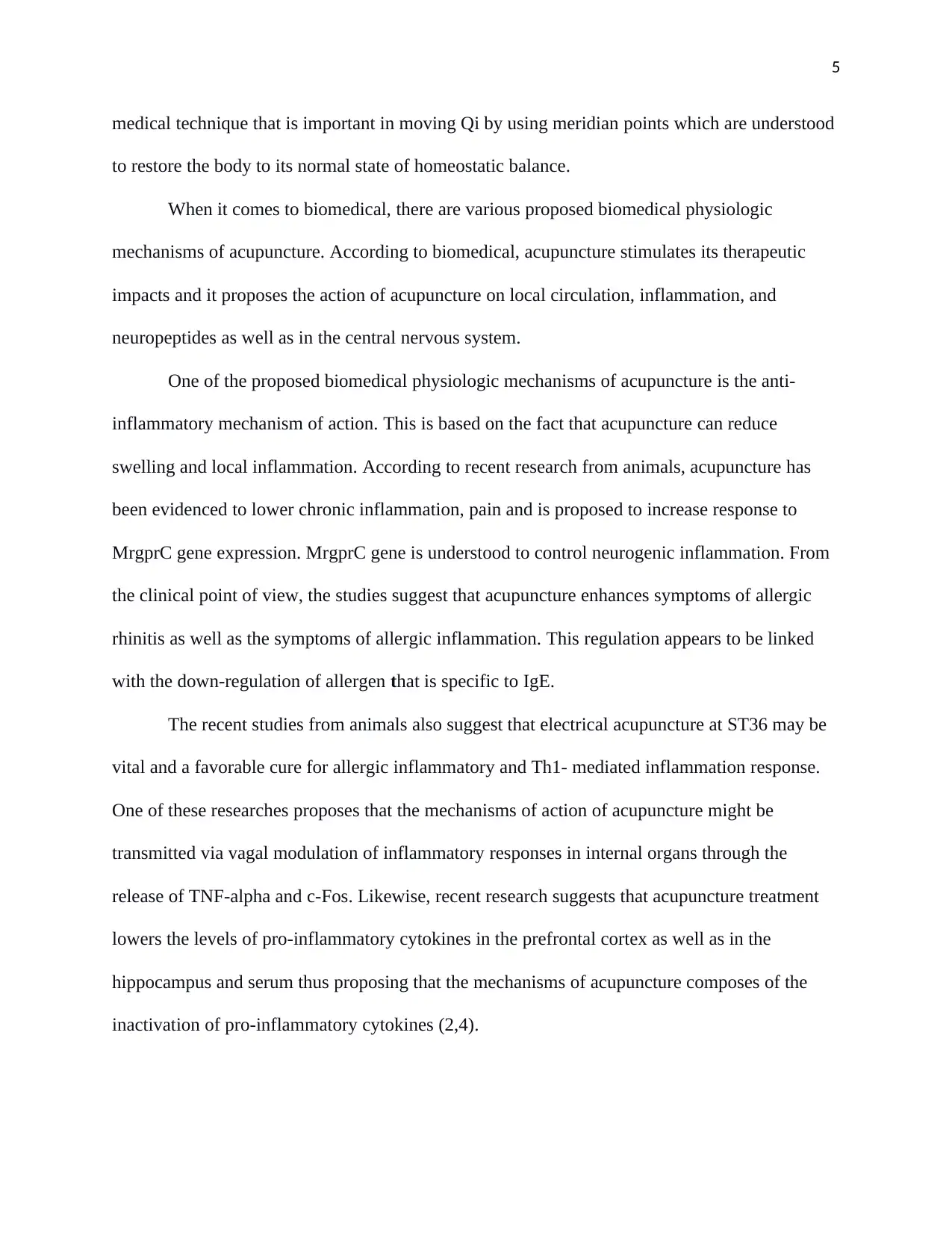
5
medical technique that is important in moving Qi by using meridian points which are understood
to restore the body to its normal state of homeostatic balance.
When it comes to biomedical, there are various proposed biomedical physiologic
mechanisms of acupuncture. According to biomedical, acupuncture stimulates its therapeutic
impacts and it proposes the action of acupuncture on local circulation, inflammation, and
neuropeptides as well as in the central nervous system.
One of the proposed biomedical physiologic mechanisms of acupuncture is the anti-
inflammatory mechanism of action. This is based on the fact that acupuncture can reduce
swelling and local inflammation. According to recent research from animals, acupuncture has
been evidenced to lower chronic inflammation, pain and is proposed to increase response to
MrgprC gene expression. MrgprC gene is understood to control neurogenic inflammation. From
the clinical point of view, the studies suggest that acupuncture enhances symptoms of allergic
rhinitis as well as the symptoms of allergic inflammation. This regulation appears to be linked
with the down-regulation of allergen that is specific to IgE.
The recent studies from animals also suggest that electrical acupuncture at ST36 may be
vital and a favorable cure for allergic inflammatory and Th1- mediated inflammation response.
One of these researches proposes that the mechanisms of action of acupuncture might be
transmitted via vagal modulation of inflammatory responses in internal organs through the
release of TNF-alpha and c-Fos. Likewise, recent research suggests that acupuncture treatment
lowers the levels of pro-inflammatory cytokines in the prefrontal cortex as well as in the
hippocampus and serum thus proposing that the mechanisms of acupuncture composes of the
inactivation of pro-inflammatory cytokines (2,4).
medical technique that is important in moving Qi by using meridian points which are understood
to restore the body to its normal state of homeostatic balance.
When it comes to biomedical, there are various proposed biomedical physiologic
mechanisms of acupuncture. According to biomedical, acupuncture stimulates its therapeutic
impacts and it proposes the action of acupuncture on local circulation, inflammation, and
neuropeptides as well as in the central nervous system.
One of the proposed biomedical physiologic mechanisms of acupuncture is the anti-
inflammatory mechanism of action. This is based on the fact that acupuncture can reduce
swelling and local inflammation. According to recent research from animals, acupuncture has
been evidenced to lower chronic inflammation, pain and is proposed to increase response to
MrgprC gene expression. MrgprC gene is understood to control neurogenic inflammation. From
the clinical point of view, the studies suggest that acupuncture enhances symptoms of allergic
rhinitis as well as the symptoms of allergic inflammation. This regulation appears to be linked
with the down-regulation of allergen that is specific to IgE.
The recent studies from animals also suggest that electrical acupuncture at ST36 may be
vital and a favorable cure for allergic inflammatory and Th1- mediated inflammation response.
One of these researches proposes that the mechanisms of action of acupuncture might be
transmitted via vagal modulation of inflammatory responses in internal organs through the
release of TNF-alpha and c-Fos. Likewise, recent research suggests that acupuncture treatment
lowers the levels of pro-inflammatory cytokines in the prefrontal cortex as well as in the
hippocampus and serum thus proposing that the mechanisms of acupuncture composes of the
inactivation of pro-inflammatory cytokines (2,4).
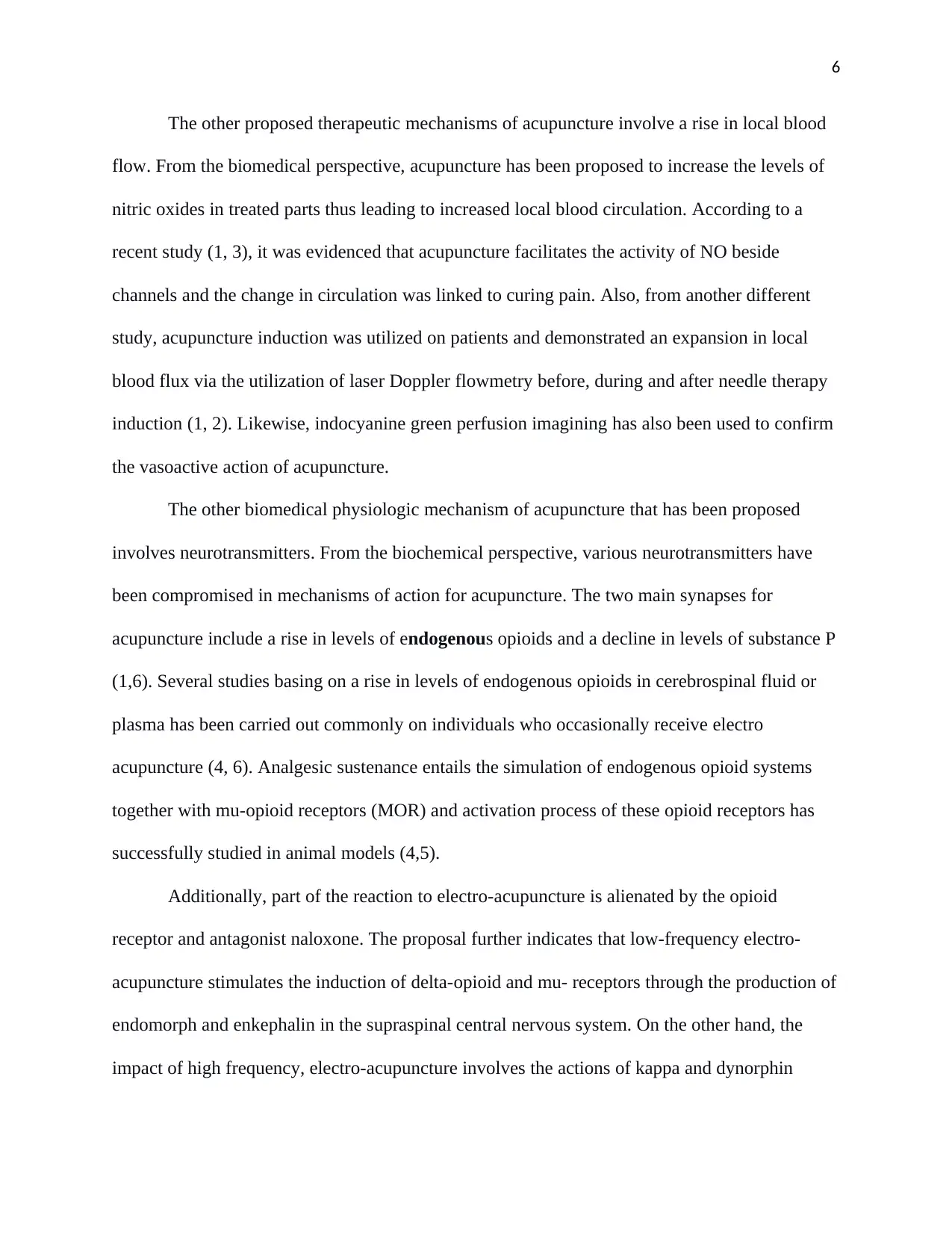
6
The other proposed therapeutic mechanisms of acupuncture involve a rise in local blood
flow. From the biomedical perspective, acupuncture has been proposed to increase the levels of
nitric oxides in treated parts thus leading to increased local blood circulation. According to a
recent study (1, 3), it was evidenced that acupuncture facilitates the activity of NO beside
channels and the change in circulation was linked to curing pain. Also, from another different
study, acupuncture induction was utilized on patients and demonstrated an expansion in local
blood flux via the utilization of laser Doppler flowmetry before, during and after needle therapy
induction (1, 2). Likewise, indocyanine green perfusion imagining has also been used to confirm
the vasoactive action of acupuncture.
The other biomedical physiologic mechanism of acupuncture that has been proposed
involves neurotransmitters. From the biochemical perspective, various neurotransmitters have
been compromised in mechanisms of action for acupuncture. The two main synapses for
acupuncture include a rise in levels of endogenous opioids and a decline in levels of substance P
(1,6). Several studies basing on a rise in levels of endogenous opioids in cerebrospinal fluid or
plasma has been carried out commonly on individuals who occasionally receive electro
acupuncture (4, 6). Analgesic sustenance entails the simulation of endogenous opioid systems
together with mu-opioid receptors (MOR) and activation process of these opioid receptors has
successfully studied in animal models (4,5).
Additionally, part of the reaction to electro-acupuncture is alienated by the opioid
receptor and antagonist naloxone. The proposal further indicates that low-frequency electro-
acupuncture stimulates the induction of delta-opioid and mu- receptors through the production of
endomorph and enkephalin in the supraspinal central nervous system. On the other hand, the
impact of high frequency, electro-acupuncture involves the actions of kappa and dynorphin
The other proposed therapeutic mechanisms of acupuncture involve a rise in local blood
flow. From the biomedical perspective, acupuncture has been proposed to increase the levels of
nitric oxides in treated parts thus leading to increased local blood circulation. According to a
recent study (1, 3), it was evidenced that acupuncture facilitates the activity of NO beside
channels and the change in circulation was linked to curing pain. Also, from another different
study, acupuncture induction was utilized on patients and demonstrated an expansion in local
blood flux via the utilization of laser Doppler flowmetry before, during and after needle therapy
induction (1, 2). Likewise, indocyanine green perfusion imagining has also been used to confirm
the vasoactive action of acupuncture.
The other biomedical physiologic mechanism of acupuncture that has been proposed
involves neurotransmitters. From the biochemical perspective, various neurotransmitters have
been compromised in mechanisms of action for acupuncture. The two main synapses for
acupuncture include a rise in levels of endogenous opioids and a decline in levels of substance P
(1,6). Several studies basing on a rise in levels of endogenous opioids in cerebrospinal fluid or
plasma has been carried out commonly on individuals who occasionally receive electro
acupuncture (4, 6). Analgesic sustenance entails the simulation of endogenous opioid systems
together with mu-opioid receptors (MOR) and activation process of these opioid receptors has
successfully studied in animal models (4,5).
Additionally, part of the reaction to electro-acupuncture is alienated by the opioid
receptor and antagonist naloxone. The proposal further indicates that low-frequency electro-
acupuncture stimulates the induction of delta-opioid and mu- receptors through the production of
endomorph and enkephalin in the supraspinal central nervous system. On the other hand, the
impact of high frequency, electro-acupuncture involves the actions of kappa and dynorphin
⊘ This is a preview!⊘
Do you want full access?
Subscribe today to unlock all pages.

Trusted by 1+ million students worldwide
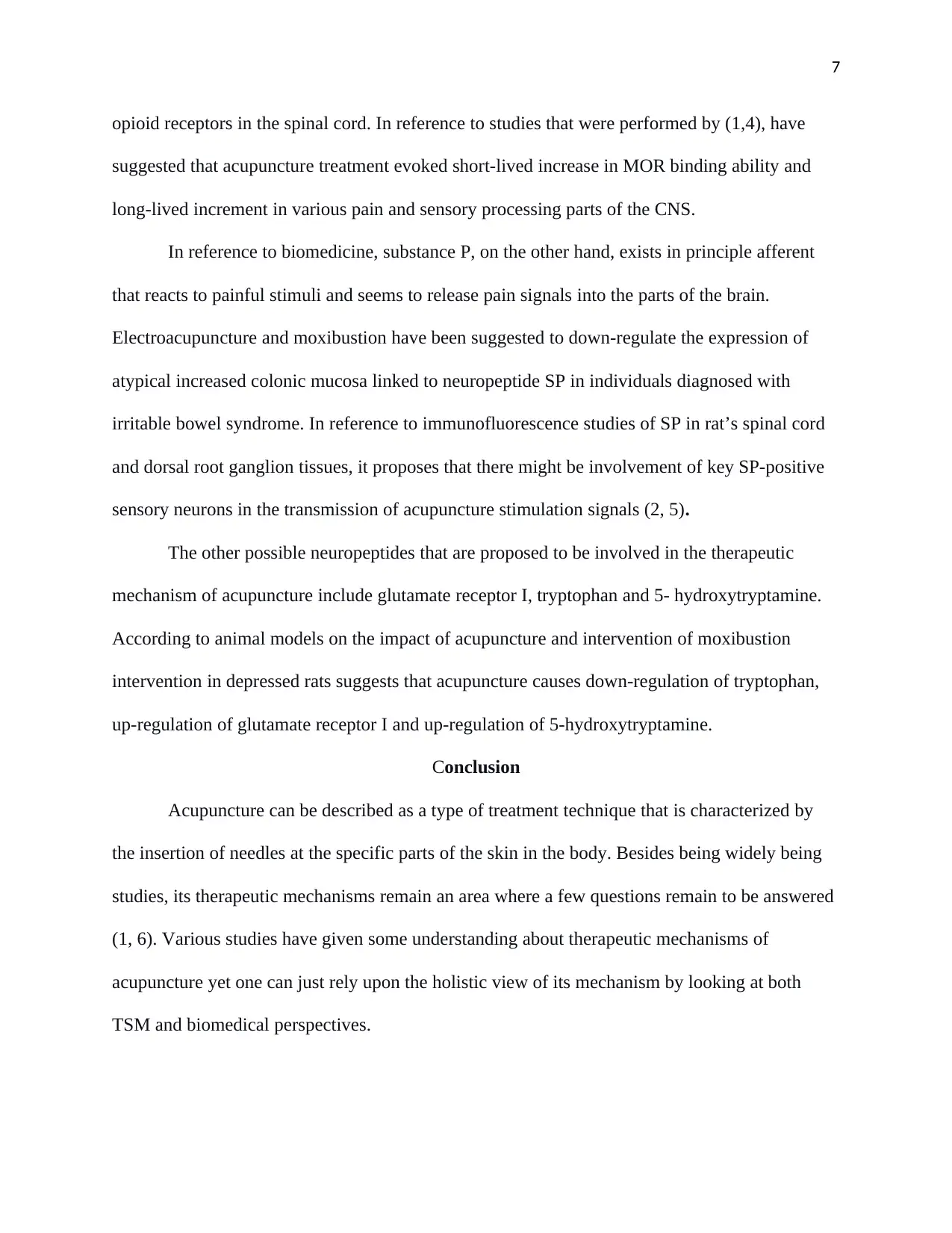
7
opioid receptors in the spinal cord. In reference to studies that were performed by (1,4), have
suggested that acupuncture treatment evoked short-lived increase in MOR binding ability and
long-lived increment in various pain and sensory processing parts of the CNS.
In reference to biomedicine, substance P, on the other hand, exists in principle afferent
that reacts to painful stimuli and seems to release pain signals into the parts of the brain.
Electroacupuncture and moxibustion have been suggested to down-regulate the expression of
atypical increased colonic mucosa linked to neuropeptide SP in individuals diagnosed with
irritable bowel syndrome. In reference to immunofluorescence studies of SP in rat’s spinal cord
and dorsal root ganglion tissues, it proposes that there might be involvement of key SP-positive
sensory neurons in the transmission of acupuncture stimulation signals (2, 5).
The other possible neuropeptides that are proposed to be involved in the therapeutic
mechanism of acupuncture include glutamate receptor I, tryptophan and 5- hydroxytryptamine.
According to animal models on the impact of acupuncture and intervention of moxibustion
intervention in depressed rats suggests that acupuncture causes down-regulation of tryptophan,
up-regulation of glutamate receptor I and up-regulation of 5-hydroxytryptamine.
Conclusion
Acupuncture can be described as a type of treatment technique that is characterized by
the insertion of needles at the specific parts of the skin in the body. Besides being widely being
studies, its therapeutic mechanisms remain an area where a few questions remain to be answered
(1, 6). Various studies have given some understanding about therapeutic mechanisms of
acupuncture yet one can just rely upon the holistic view of its mechanism by looking at both
TSM and biomedical perspectives.
opioid receptors in the spinal cord. In reference to studies that were performed by (1,4), have
suggested that acupuncture treatment evoked short-lived increase in MOR binding ability and
long-lived increment in various pain and sensory processing parts of the CNS.
In reference to biomedicine, substance P, on the other hand, exists in principle afferent
that reacts to painful stimuli and seems to release pain signals into the parts of the brain.
Electroacupuncture and moxibustion have been suggested to down-regulate the expression of
atypical increased colonic mucosa linked to neuropeptide SP in individuals diagnosed with
irritable bowel syndrome. In reference to immunofluorescence studies of SP in rat’s spinal cord
and dorsal root ganglion tissues, it proposes that there might be involvement of key SP-positive
sensory neurons in the transmission of acupuncture stimulation signals (2, 5).
The other possible neuropeptides that are proposed to be involved in the therapeutic
mechanism of acupuncture include glutamate receptor I, tryptophan and 5- hydroxytryptamine.
According to animal models on the impact of acupuncture and intervention of moxibustion
intervention in depressed rats suggests that acupuncture causes down-regulation of tryptophan,
up-regulation of glutamate receptor I and up-regulation of 5-hydroxytryptamine.
Conclusion
Acupuncture can be described as a type of treatment technique that is characterized by
the insertion of needles at the specific parts of the skin in the body. Besides being widely being
studies, its therapeutic mechanisms remain an area where a few questions remain to be answered
(1, 6). Various studies have given some understanding about therapeutic mechanisms of
acupuncture yet one can just rely upon the holistic view of its mechanism by looking at both
TSM and biomedical perspectives.
Paraphrase This Document
Need a fresh take? Get an instant paraphrase of this document with our AI Paraphraser
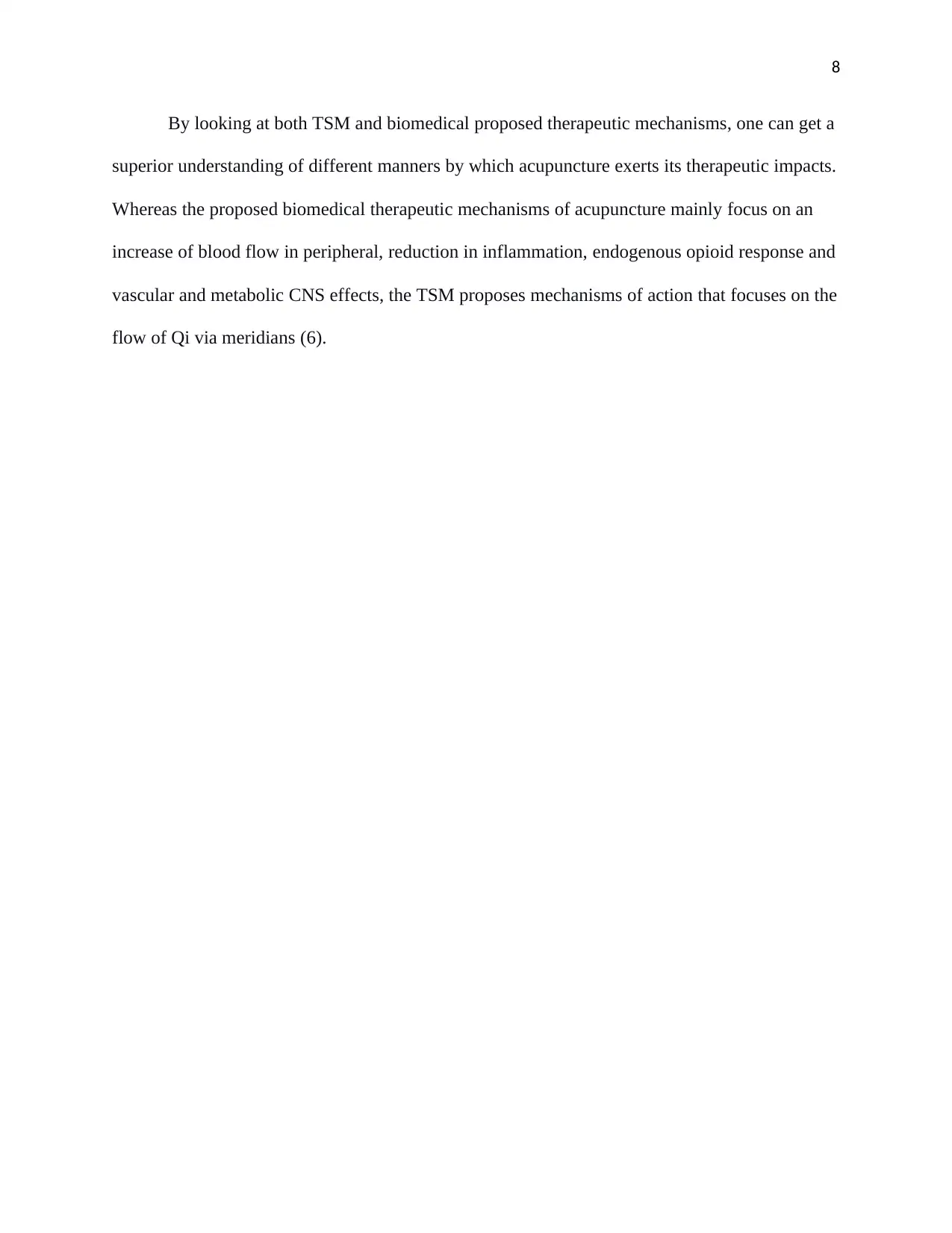
8
By looking at both TSM and biomedical proposed therapeutic mechanisms, one can get a
superior understanding of different manners by which acupuncture exerts its therapeutic impacts.
Whereas the proposed biomedical therapeutic mechanisms of acupuncture mainly focus on an
increase of blood flow in peripheral, reduction in inflammation, endogenous opioid response and
vascular and metabolic CNS effects, the TSM proposes mechanisms of action that focuses on the
flow of Qi via meridians (6).
By looking at both TSM and biomedical proposed therapeutic mechanisms, one can get a
superior understanding of different manners by which acupuncture exerts its therapeutic impacts.
Whereas the proposed biomedical therapeutic mechanisms of acupuncture mainly focus on an
increase of blood flow in peripheral, reduction in inflammation, endogenous opioid response and
vascular and metabolic CNS effects, the TSM proposes mechanisms of action that focuses on the
flow of Qi via meridians (6).
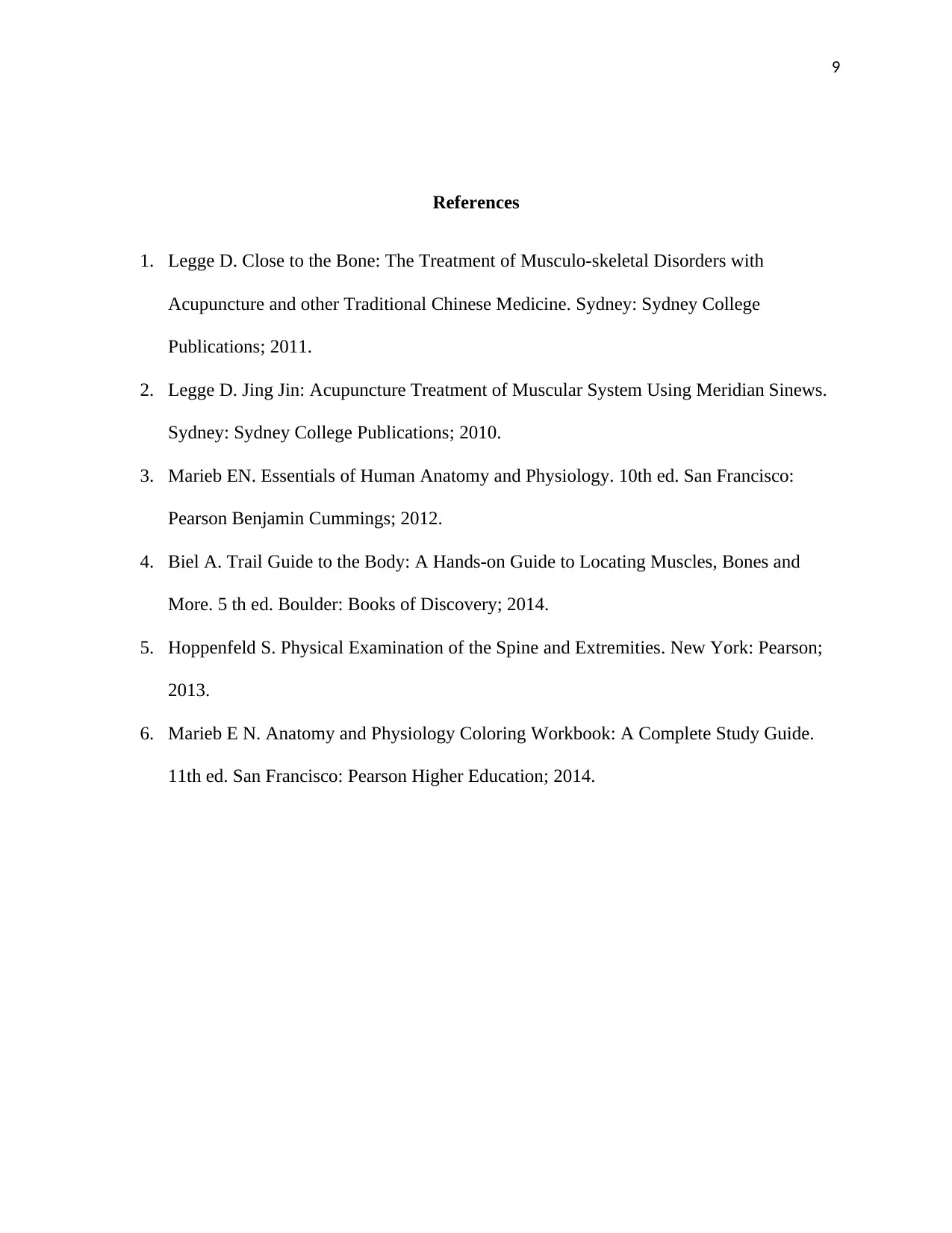
9
References
1. Legge D. Close to the Bone: The Treatment of Musculo-skeletal Disorders with
Acupuncture and other Traditional Chinese Medicine. Sydney: Sydney College
Publications; 2011.
2. Legge D. Jing Jin: Acupuncture Treatment of Muscular System Using Meridian Sinews.
Sydney: Sydney College Publications; 2010.
3. Marieb EN. Essentials of Human Anatomy and Physiology. 10th ed. San Francisco:
Pearson Benjamin Cummings; 2012.
4. Biel A. Trail Guide to the Body: A Hands-on Guide to Locating Muscles, Bones and
More. 5 th ed. Boulder: Books of Discovery; 2014.
5. Hoppenfeld S. Physical Examination of the Spine and Extremities. New York: Pearson;
2013.
6. Marieb E N. Anatomy and Physiology Coloring Workbook: A Complete Study Guide.
11th ed. San Francisco: Pearson Higher Education; 2014.
References
1. Legge D. Close to the Bone: The Treatment of Musculo-skeletal Disorders with
Acupuncture and other Traditional Chinese Medicine. Sydney: Sydney College
Publications; 2011.
2. Legge D. Jing Jin: Acupuncture Treatment of Muscular System Using Meridian Sinews.
Sydney: Sydney College Publications; 2010.
3. Marieb EN. Essentials of Human Anatomy and Physiology. 10th ed. San Francisco:
Pearson Benjamin Cummings; 2012.
4. Biel A. Trail Guide to the Body: A Hands-on Guide to Locating Muscles, Bones and
More. 5 th ed. Boulder: Books of Discovery; 2014.
5. Hoppenfeld S. Physical Examination of the Spine and Extremities. New York: Pearson;
2013.
6. Marieb E N. Anatomy and Physiology Coloring Workbook: A Complete Study Guide.
11th ed. San Francisco: Pearson Higher Education; 2014.
⊘ This is a preview!⊘
Do you want full access?
Subscribe today to unlock all pages.

Trusted by 1+ million students worldwide
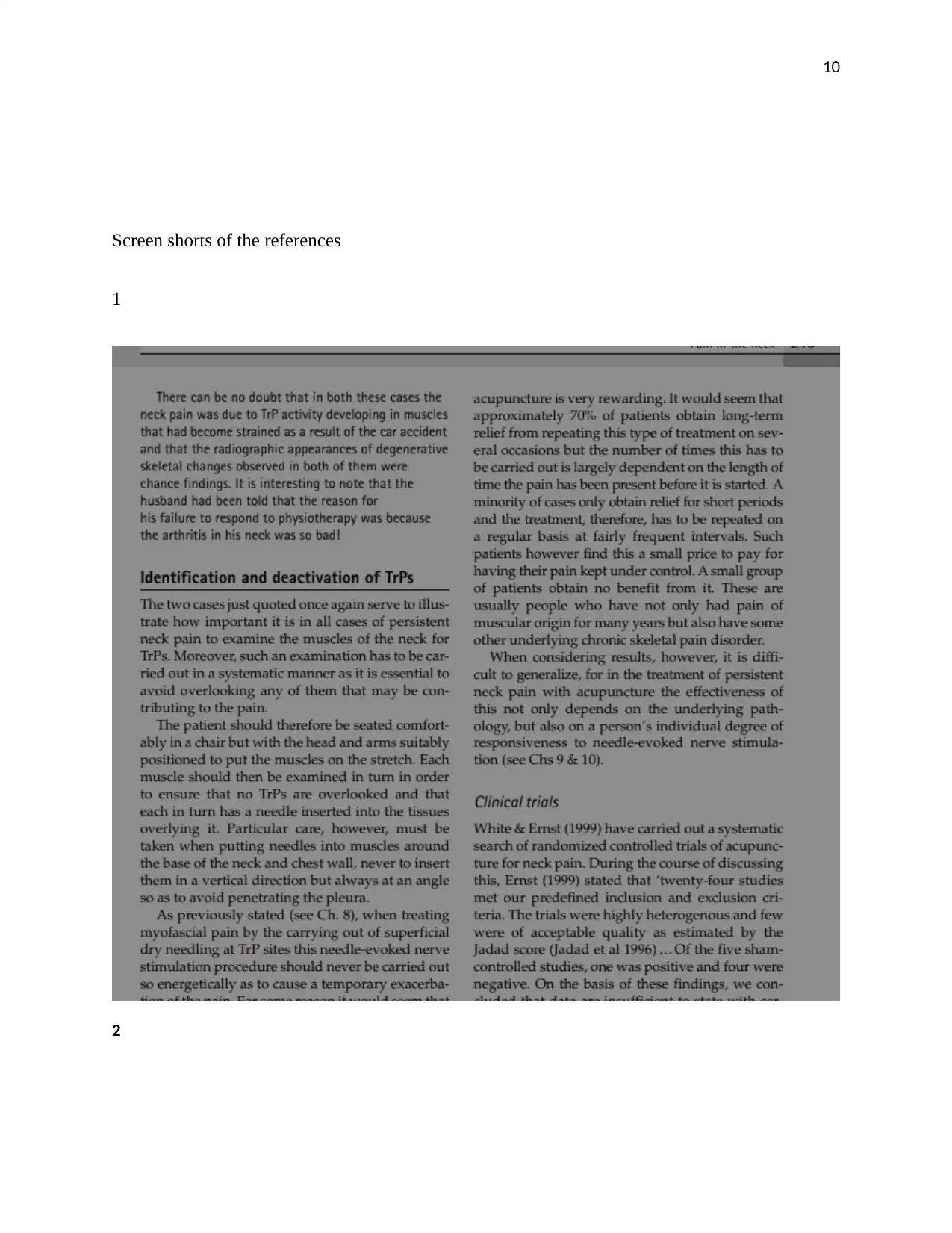
10
Screen shorts of the references
1
2
Screen shorts of the references
1
2
Paraphrase This Document
Need a fresh take? Get an instant paraphrase of this document with our AI Paraphraser
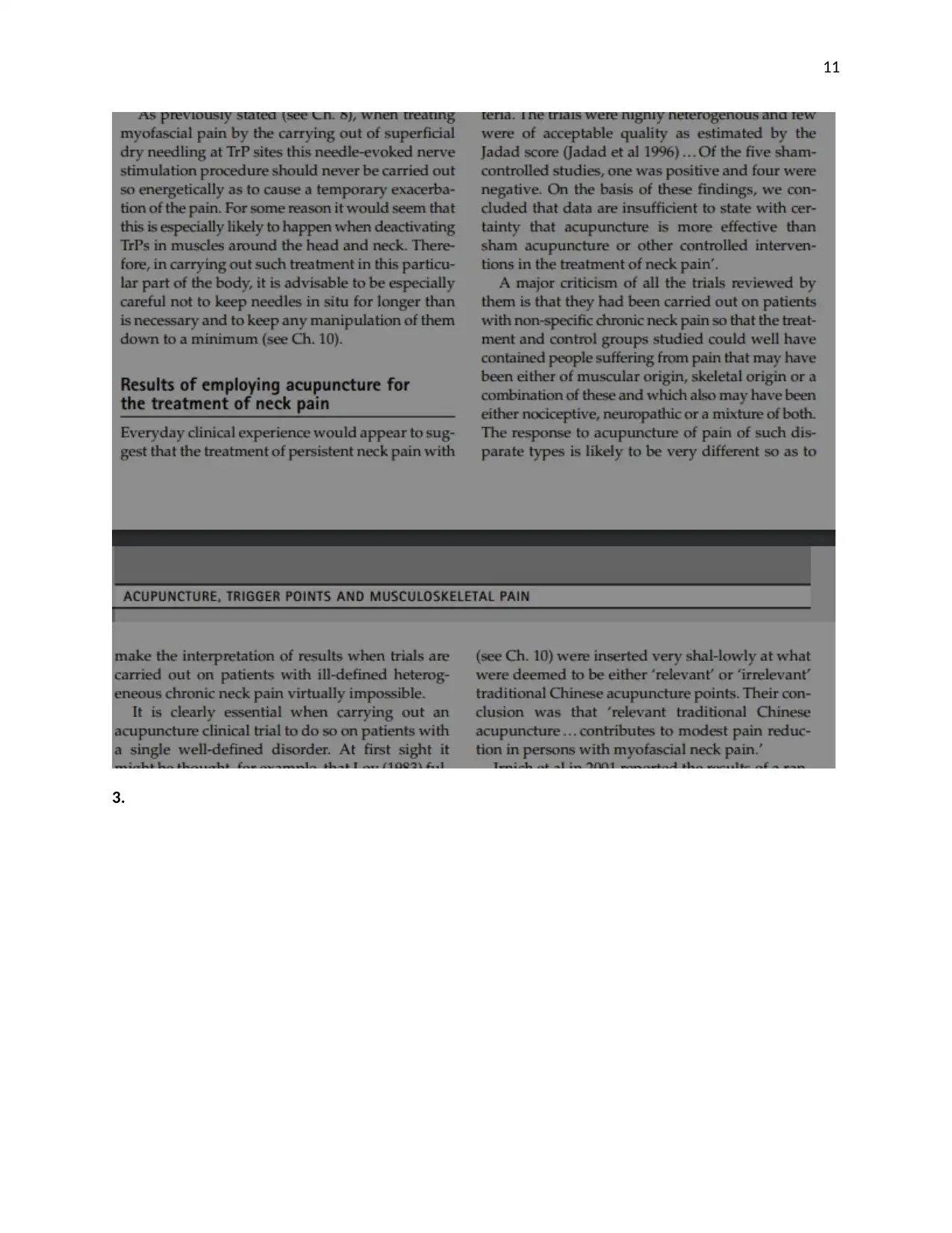
11
3.
3.
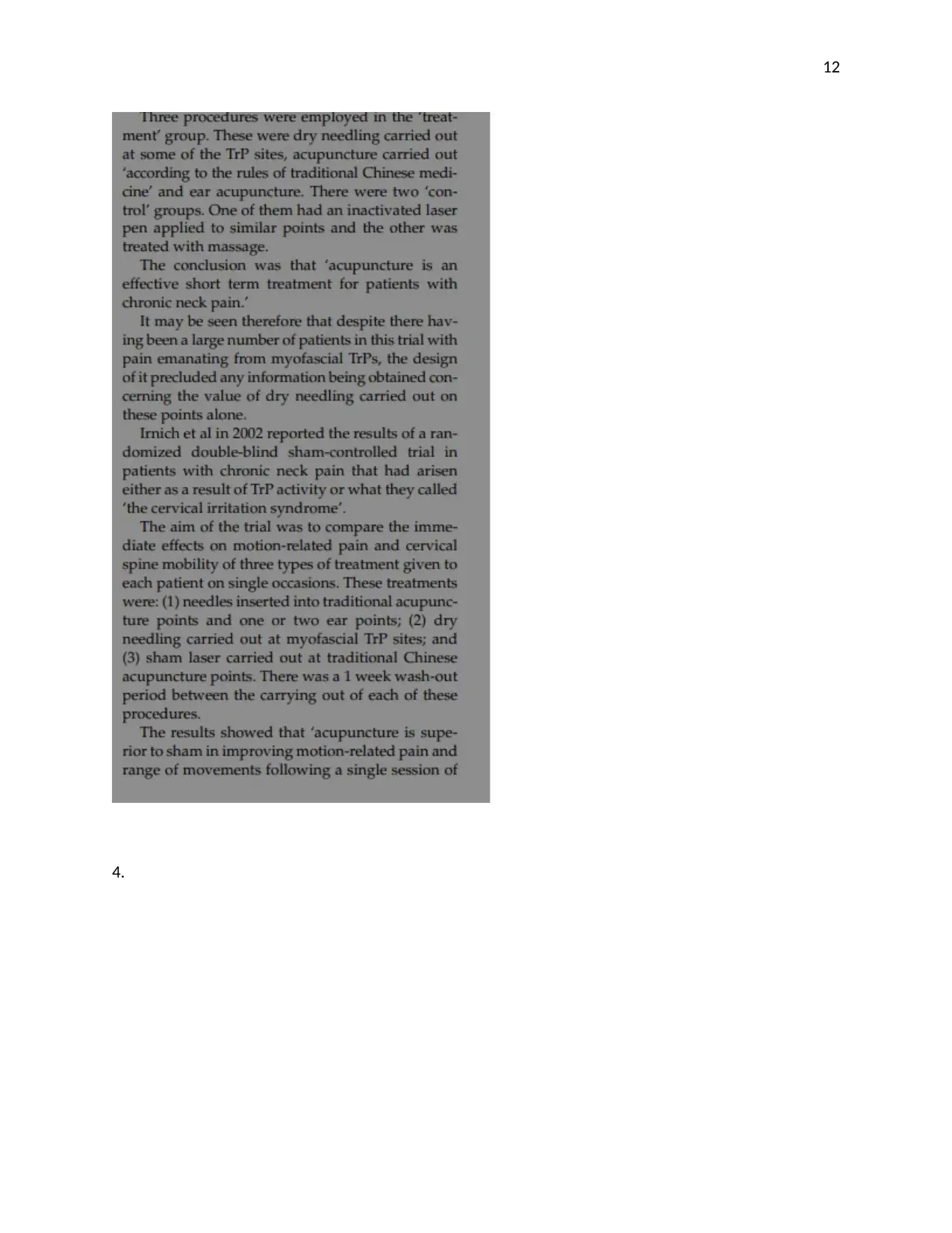
12
4.
4.
⊘ This is a preview!⊘
Do you want full access?
Subscribe today to unlock all pages.

Trusted by 1+ million students worldwide
1 out of 16
Related Documents
Your All-in-One AI-Powered Toolkit for Academic Success.
+13062052269
info@desklib.com
Available 24*7 on WhatsApp / Email
![[object Object]](/_next/static/media/star-bottom.7253800d.svg)
Unlock your academic potential
Copyright © 2020–2025 A2Z Services. All Rights Reserved. Developed and managed by ZUCOL.




